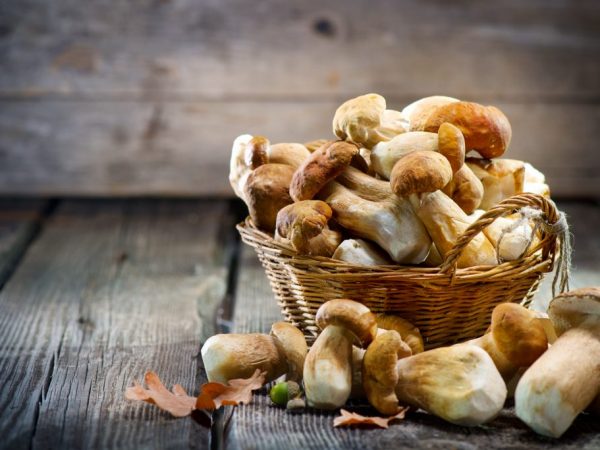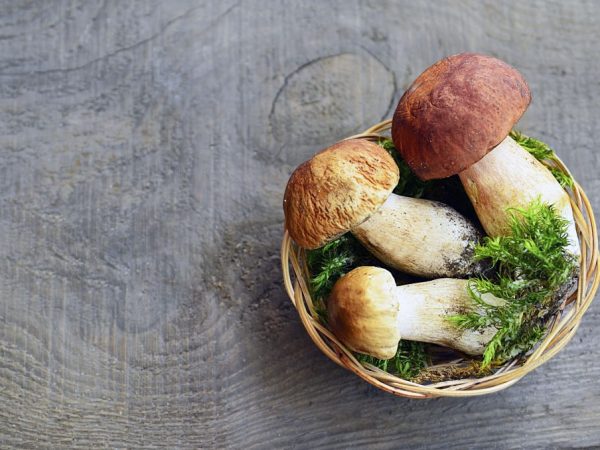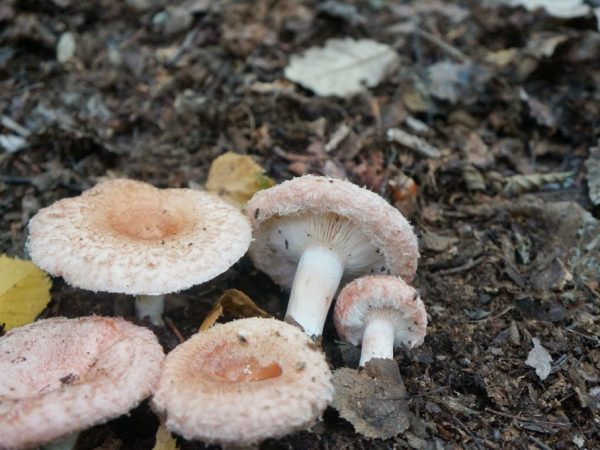June harvest of mushrooms in the Moscow region
The Moscow region has a fertile soil for the growth of fungi. Lovers of "quiet hunting" in the Moscow region, they pamper in June with their diversity: here you can find boletus, aspen, white. And still other, no less tasty varieties.

June harvest of mushrooms in the Moscow region
Butterlets
They are distinguished by caps of a convex or round shape, yellow or light brown. It has a sticky or slimy surface in the fungus, which can be easily removed with a knife. If you wet the mushroom at the same time, it will begin to slip out of your hands. Young specimens have a blanket under the hat. The leg is white, may have a grainy surface, which can also be easily removed with a knife. The pulp is white.
Irina Selyutina (Biologist):
The genus Oiler includes about 50 species. Its representatives are distributed mainly in the temperate regions of the northern hemisphere. The fruit body is small to medium in size; the cap is usually slimy, sticky; the leg is solid, with a ring - the remainder of a private filmy blanket or with warts (grains, glands), or with both together and less often without them. The trama (false tissue) of the tubules is divergent. Mushrooms of the genus Oily are mycorrhizal formers that enter into symbiotic relationships with conifers. Many species are characterized by a fairly high nutritional value and belong to category 2 mushrooms.
To collect oils, it is better to take gloves with you to protect your hands from staining with pigments present in the skin of the caps of these mushrooms.
Many mushroom pickers do not like representatives of the Oiler genus because of their lengthy preparation for cooking and their small size. Gribnikov is not even inspired by the fact that butter has a pleasant taste and aroma.

Butters are distinguished by a convex shape
Lattice or goat
The mushroom goat or dry oiler is characterized by the following features:
- the skin from the cap either comes off very badly (in pieces) or does not come off at all;
- the surface of the cap, in comparison with other species of kids, is slightly mucous, which is clearly reflected in the species name of the synonym;
- the layer of tubules of the hymenophore is smoothly descending from the lower surface of the cap to the leg;
- the pores of the tubules are large, have a peculiar irregular angularity and torn edges;
- the pulp at the beginning of growth is dense and elastic, by the time of aging it becomes rubbery. Its pale yellow color in the cap, if the integrity of the surface is violated, may slightly redden (turn pink).
- the leg is often curved closer to the base, sometimes narrowed downward.
The shape of the cap in young mushrooms is convex, but for old ones it is already characterized by a flat or pillow-like one. Smooth and slightly sticky to the touch.
The pulp of the mushroom after heat treatment becomes a mauve shade.
Yellow-brown or orange-brown color. The grill has no sharp taste, it is slightly sour.
Row gray
This type is very often called streaky ryadovka in Russian.The hat is large (up to 10-12 cm in diameter), fleshy, has wavy edges, which, moreover, can be slightly torn. The shape is flat-convex, later prostrate, with a blunt tubercle in the center. Its surface is weakly sticky. Color from light gray to dark gray, sometimes olive, somewhat darker in the center, covered with dark hairs located radially.
The plates are wide, sparse, can be adhered with a tooth (to the stem) or free. Their color changes with age from white to grayish with a characteristic yellowish tinge.
The pulp is white, dense, has a sweetish taste and smell of fresh flour. By its color, the pulp is white or grayish, at the break it can acquire a yellowish tint. The leg is thickened at the base, has a cylindrical shape, in the upper part it is covered with a mealy bloom. It can be characterized as deeply rooted, i.e. immersed in forest deciduous litter or moss litter.
The gray row forms mycorrhiza with pines.
The species has twins:
- Pointed row: poisonous species, the owner of a thin ash-gray cap with a conical tubercle in the center, grayish plates and a burning taste of the pulp.
- Soap row: an inedible species, for which a noticeably pronounced smell of cheap soap is inherent, a pulp that turns red when broken, a bitter taste. The leg tapering downwards is covered with small blackish scales.
- The row is different: conditionally edible, with a green or brown cap, a white stem, and an unpleasant odor.
- Earthy row: edible appearance, outwardly different from the river. gray, much smaller, the surface of the cap (fibers and scales are present), gray plates of the hymenophore, located less often.
Summer mushrooms
Most often they grow on stumps, rotting wood and birch deadwood. It is extremely rare on conifers.
While the honey agaric is small, his hat resembles a bell; over time, the hat begins to open and takes on a flat shape. The edges are torn. The color is light brown. The leg is thin and small. This mushroom does not grow alone, there is always a company of fellows near it.
Experts say about the strong variability of the summer mushroom, which was confirmed in the species synonym - "mutabilis", so it is very difficult to distinguish it from the poisonous twin - the bordered gallerina. Therefore, it is better not to collect honey mushrooms in coniferous forests on stumps left over from coniferous trees.
Meadow mushrooms
Meadow mushrooms belong to the Negniychnikovye family and grow in a meadow or other open area. The cap is rounded, during growth it changes shape up to almost spread, but retains the tubercle in the center. A slightly noticeable zoning may appear in a yellowish-brown color.
The leg is thin, long, slightly sinuous. The pulp is pale, thin. The plates of the hymenophore are rather rare. Honey mushrooms are distinguished by a well-defined clove aroma and sweet taste.
Common Dubovik
The shape of the cap is convex, hemispherical, sometimes cushion-shaped. In girth it can reach 7-25 cm. The skin is soft, slightly slimy, olive-mustard, chestnut color. The common oak tree has a distinctive feature: after touching the cap with your fingers, dark marks remain on it. The pulp is yellow, soft, fleshy. It has no specific smell and taste. A specific reaction is the blueing of the pulp on the cut.
The leg is dense, clavate, has a characteristic "islet" -thickness at the base.
Irina Selyutina (Biologist):
Common oak tree, or as it is also called olive-brown oak tree, or bruise, refers to pain mushrooms. In the early 1970s, in the special literature, especially in Western European, the presence of poisonous and even very poisonous species of mushrooms among the painful ones was very often noted. The record was set by the satanic mushroom (Boletus satanas). But besides him, reports of the toxicity of fresh mushrooms have often appeared in relation to other species.The common oak tree (Boletus luridus), which in German became known as "Hexenpiiz" (witch's mushroom), also got there.
To date, it has been clearly established that although toxins are contained in the fruit bodies of the common oak tree, they are destroyed during cooking, that is, they are thermolabile. But a raw or poorly cooked mushroom causes intestinal upset. Also, it is not recommended to use it as a snack for alcoholic beverages.
This species forms mycorrhiza with oak, beech, sometimes with birch, spruce, or other tree species. The common oak tree is a conditionally edible mushroom. Most often pickled, and with the addition of citric acid, which makes the blue pulp light.
Pink hair
The cap of the mushroom is round, in the young it is distinguished by its convexity, but over time it flattens, as a result of which a depression is formed in the center, which is called the "umbilical" one. There is a small amount of mucus on the surface. The skin covering the cap is provided with dense and rather coarse in structure villi, which, being arranged in circles, create the impression of a concentric pattern. It has a peculiar gray-pink color, which fades in dry weather, becoming almost white, which can lead to confusion and mushroom pickers will take the appearance for a white wave.
The pulp is white, strong, dense, has a pungent taste. For the pink wave, as a representative of the Mlechnik genus, the presence of abundant white milky juice with a pungent taste is characteristic, which does not change color even upon contact with air.
The leg is large, solid, thick and very dense. In young mushrooms, it is whole, in adults, cavities appear in it. It is painted in a pale pink color. The leg tapers towards the base. Its surface is velvety to the touch due to the cannon covering it.
White wolf, or white
The surface of the cap is white, the middle of the surface is dark, the edges are strongly curled in the young mushroom. The cap is initially convex, then becomes funnel-shaped, with a mucous surface. The surface also has a peculiar, felt-like cover of a mass of hairs. It is especially well developed in young mushrooms and at the edges of the cap. Old mushrooms may turn yellow on the surface. Concentrically zones, visible on the pink cap of the wave, at V. white is practically invisible.
By the way. The length of the leg depends on the habitat. So in specimens growing in open areas, the leg is very short and reaches 2-4 cm, but if the mushroom grows in dense and tall grass, its height can reach 8 cm.
The pulp is brittle, white in color, the taste is given to it by a pungent white milky juice. The aroma is sweetish, pleasant.

White mushroom description
Where to go for mushrooms
In June, a good basket of edible butter will gather in the Moscow region, the main thing is to choose the right direction:
- Leningradskoe;
- Yaroslavskoe;
- Ryazanskoe;
- Kazanskoe;
- Pyalovskoe reservoir;
- Savelovskaya road.
When to collect
Mushrooms are harvested at any daytime, in the indicated directions or recommended places. But it is better to go to picking mushrooms early in the morning, no later than 5-6 hours. In this case, you must first:
study the map of the area;
view (carefully) the atlas of mushrooms;
make a list of everything you need;
warn loved ones about where, why and how long you are going;
fully charge your phone and top up your balance;
choose the "right" clothes and shoes;
take a container from natural materials, etc.
It is also important to remember that mushrooms begin to grow more actively after rain. And the most important thing is not to forget the main rule of the mushroom picker: "I'm not sure that the mushroom you like is edible - don't touch it, pass by."
Conclusion
Mushrooms in June is the beginning of the mushroom season in the Moscow region. This region is rich in different types of this tasty and healthy product.
When picking mushrooms, you need to be concentrated and attentive. Toadstools and fly agarics have gone through more than one mutation and are similar to edible species.



